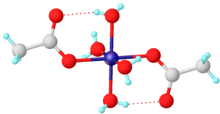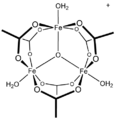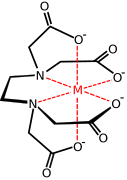Transition metal carboxylate complex

Transition metal carboxylate complexes are coordination complexes with carboxylate (RCO2−) ligands. Reflecting the diversity of carboxylic acids, the inventory of metal carboxylates is large. Many are useful commercially, and many have attracted intense scholarly scrutiny. Carboxylates exhibit a variety of coordination modes, most common are κ1- (O-monodentate), κ2 (O,O-bidentate), and bridging.
[]
Structure and bonding[]
Carboxylates bind to single metals by one or both oxygen atoms, κ1- and κ2 )m)-. In terms of electron counting, κ1- and κ2 )m)- are "X", a pseudohalide, and "L-X ligands", i.e. a combination of a Lewis base (L) and a pseudohalide (X). Carboxylates are classified as hard ligands, in HSAB theory.
- Structures of Selected Metal Acetates

Basic ferric acetate

Silver acetate

Basic zinc acetate

Molybdenum(II) acetate, illustrating the Mo-Mo quadruple bond.[1]

[CoO(acetate)]4, the "Das cubane"
For simple carboxylates, the acetate complexes are illustrative. Most transition metal acetates are mixed ligand complexes. One common example is hydrated nickel acetate, Ni(O2CCH3)2(H2O)4, which features intramolecular hydrogen-bonding between the uncoordinated oxygens and the protons of aquo ligands. Stoichiometrically simple complexes are often multimetallic. One family are the basic metal acetates, of the stoichiometry [M3O(OAc)6(H2O)3]n+.[2]
Anhydrous or nearly anhydrous acetates often are [[coordination polymers. Some however adopt the Chinese lantern structure. Well studied examples include the dimetal tetraacetates (M2(OAc)4) where M = Cu(II), Rh(II), Cr(II), and Mo(II). Platinum diacetate and palladium diacetate feature Pt4 and Pd3 cores, further illustrating the tendency of acetate ligands to stabilize multimetallic structures.

Reactions and applications[]
Metal acetates are common catalysts or precatalysts. Particularly useful are the lipophlic complexes of ethylhexanoates.
Di- and polycarboxylates[]
Benzenedi- and tricarboxylates[]
Metal organic frameworks, porous, three-dimensional coordination polymers, are often derived from metal carboxylate clusters. These clusters, called secondary bonding units (SBU's), are often linked by the conjugate bases of benzenedi- and tricarboxylic acids.[4]
Aminopolycarboxylates[]

metal complex with the EDTA anion

Ferric bis(iminodiacetate)

Active site of hemerythrin, an O2-carrying iron-carboxylate
A commercially important family of metal carboxylates are derived from aminopolycarboxylates, e.g., EDTA4-. Related to these synthetic chelating agents are the amino acids, which form large families of amino acid complexes. Two amino acids, glutamate and aspartate, have carboxylate side chains, which function as ligands for iron in nonheme iron proteins, such as hemerythrin.[5]
References[]
- ^ Brignole, Alicia B.; Cotton, F. A. (1972). "Rhenium and Molybdenum Compounds Containing Quadruple Bonds". Inorganic Syntheses. 13: 81–89. doi:10.1002/9780470132449.ch15.
- ^ Catterick, Janet; Thornton, Peter (1977). Structures and Physical Properties of Polynuclear Carboxylates. Advances in Inorganic Chemistry and Radiochemistry. Vol. 20. pp. 291–362. doi:10.1016/S0065-2792(08)60041-2. ISBN 9780120236206.
- ^ Zhang, Gao; Lin, Jian; Guo, Dong-Wei; Yao, Shi-Yan; Tian, Yun-Qi (2010). "Infinite Coordination Polymers of One- and Two-dimensional Cobalt Acetates". Zeitschrift für Anorganische und Allgemeine Chemie. 636 (7): 1401–1404. doi:10.1002/zaac.200900457.
- ^ Tranchemontagne, David J.; Mendoza-Cortés, José L.; o'Keeffe, Michael; Yaghi, Omar M. (2009). "Secondary Building Units, Nets and Bonding in the Chemistry of Metal–Organic Frameworks". Chemical Society Reviews. 38 (5): 1257. doi:10.1039/b817735j. PMID 19384437.
- ^ Jasniewski, Andrew J.; Que, Lawrence (2018). "Dioxygen Activation by Nonheme Diiron Enzymes: Diverse Dioxygen Adducts, High-Valent Intermediates, and Related Model Complexes". Chemical Reviews. 118 (5): 2554–2592. doi:10.1021/acs.chemrev.7b00457. PMC 5920527. PMID 29400961.
- Ligands
- Coordination chemistry
- Salts of carboxylic acids






